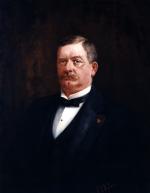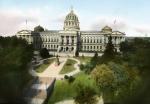![header=[Marker Text] body=[Governor of Pennsylvania, 1899-1903; Congressman in 1891-99, was born two and one-half miles SW of here Apr. 18, 1846. Graduate of Mansfield Normal. Began law practice in Wellsboro. 1870. Moved to Pittsburgh, 1877. Died Mar. 1, 1920. ] sign](kora/files/1/10/1-A-3B6-139-ExplorePAHistory-a0m8c3-a_450.jpg)
Mouse over for marker text
Name:
William A. Stone
Region:
Allegheny National Forest Region
County:
Tioga
Marker Location:
Courthouse Square, Pa. 287 and 660, Wellsboro
Dedication Date:
September 1, 1948
Behind the Marker
William A. Stone was typical of the Republican Party stalwarts who won elective office in Pennsylvania during the late 1800s. A poor farm boy from Tioga County, Stone at the age of seventeen ran off to join the Union army, after the Battle of Gettysburg. His father refused to allow him to join, but as soon as Stone turned eighteen he reenlisted in the "Keystone Brigade" of the 187th Pennsylvania Volunteers. Stone then served with the Army of the Potomac during the year-long campaign in Virginia that ended the war, and rose through the ranks from private to second lieutenant.
After the war, the principal of the Mansfield State Normal School (now Mansfield University) in his home county admitted Stone to the school with financial support. Upon graduation in 1868, he became principal of an academy in Wellsboro, studied law, and was admitted to the bar in 1870. In 1872, Stone became clerk of the state House of Representatives; two years later the people of Tioga County elected him their district attorney.
Two years after that, in the centennial year of 1876, Stone moved to Pittsburgh, where his skill as a trial lawyer brought him to the attention of the state's Republican leaders. In 1880, President Rutherford Hayes appointed him the United States district attorney for Pennsylvania's western district. A staunch Republican, Stone retained his office until 1886, when President Grover Cleveland, a Democrat, dismissed him for refusing to obey an order that federal officials refrain from campaigning for political candidates. Stone returned to his law practice until he was elected to Congress in 1890.
In 1898, Republican state boss Matthew Quay selected Stone to represent the party as his candidate for governor. Progressive Republican and department-store magnate
Matthew Quay selected Stone to represent the party as his candidate for governor. Progressive Republican and department-store magnate  John Wanamaker challenged Quay in the primary by supporting reform candidate Charles W. Stone (no relation). Backed by Republican conservatives, William Stone won the primary and then won the general election, defeating Democrat George Jenks by 118,000 votes out of nearly a million cast. Stone then showed his gratitude by appointing Quay to succeed
John Wanamaker challenged Quay in the primary by supporting reform candidate Charles W. Stone (no relation). Backed by Republican conservatives, William Stone won the primary and then won the general election, defeating Democrat George Jenks by 118,000 votes out of nearly a million cast. Stone then showed his gratitude by appointing Quay to succeed  Donald Cameron in the United States Senate, even though Quay was under indictment for stealing state funds.
Donald Cameron in the United States Senate, even though Quay was under indictment for stealing state funds.
During his governorship, the state legislature was to reduce the state debt, but otherwise his regime was undistinguished. He remained aloof from the six-month anthracite-coal strike of 1902, allowing the coal bosses to handle the walkout their way. This time, however, the laissez-faire policies of state government backfired. When the nation was threatened with a coal shortage during the winter of 1902-1903, President Theodore Roosevelt stepped in and, with the help of J.P. Morgan, set up a Commission that arbitrated in favor of the miners and the
anthracite-coal strike of 1902, allowing the coal bosses to handle the walkout their way. This time, however, the laissez-faire policies of state government backfired. When the nation was threatened with a coal shortage during the winter of 1902-1903, President Theodore Roosevelt stepped in and, with the help of J.P. Morgan, set up a Commission that arbitrated in favor of the miners and the United Mine Workers Union, Roosevelt's intervention set a new precedent: It was the first time in American history that the federal government interceded in a labor dispute on behalf of the workers.
United Mine Workers Union, Roosevelt's intervention set a new precedent: It was the first time in American history that the federal government interceded in a labor dispute on behalf of the workers.
In the early 1900s, Roosevelt embodied the Progressive Republicans who now dominated the national party and who believed it was necessary for "big government" to intercede on behalf of the public against the abuses of big business - and the state politicians who did their bidding. Stone's administration also awarded the contract to construct a new state Capitol building to replace the one that burned down in 1897.
new state Capitol building to replace the one that burned down in 1897.
The new state capitol would soon symbolize both the grand ambitions and the endemic corruption of Pennsylvania state government. Several officials involved in construction of the grand building and architect Joseph Huston went to jail for padding the accounts and stealing funds. Stone also supported Quay and his partner John Mack by approving a bill authorizing them to build trolley lines in Philadelphia to replace the existing system owned by Philadelphia transit mogul Peter Widener and his partner William Elkins. (Quay had been a partner in Widener's hugely profitable Philadelphia Transit Company before a dispute had led to a parting of the ways.)
After stepping down as governor, in 1903 Stone returned to his private law practice. He later served as prothonotary of the state Supreme Court in 1915 and the state Superior Court in 1916. William Stone died on March 1, 1920, and is buried in Wellsboro Cemetery, Tioga County.
After the war, the principal of the Mansfield State Normal School (now Mansfield University) in his home county admitted Stone to the school with financial support. Upon graduation in 1868, he became principal of an academy in Wellsboro, studied law, and was admitted to the bar in 1870. In 1872, Stone became clerk of the state House of Representatives; two years later the people of Tioga County elected him their district attorney.
Two years after that, in the centennial year of 1876, Stone moved to Pittsburgh, where his skill as a trial lawyer brought him to the attention of the state's Republican leaders. In 1880, President Rutherford Hayes appointed him the United States district attorney for Pennsylvania's western district. A staunch Republican, Stone retained his office until 1886, when President Grover Cleveland, a Democrat, dismissed him for refusing to obey an order that federal officials refrain from campaigning for political candidates. Stone returned to his law practice until he was elected to Congress in 1890.
In 1898, Republican state boss
During his governorship, the state legislature was to reduce the state debt, but otherwise his regime was undistinguished. He remained aloof from the six-month
In the early 1900s, Roosevelt embodied the Progressive Republicans who now dominated the national party and who believed it was necessary for "big government" to intercede on behalf of the public against the abuses of big business - and the state politicians who did their bidding. Stone's administration also awarded the contract to construct a
The new state capitol would soon symbolize both the grand ambitions and the endemic corruption of Pennsylvania state government. Several officials involved in construction of the grand building and architect Joseph Huston went to jail for padding the accounts and stealing funds. Stone also supported Quay and his partner John Mack by approving a bill authorizing them to build trolley lines in Philadelphia to replace the existing system owned by Philadelphia transit mogul Peter Widener and his partner William Elkins. (Quay had been a partner in Widener's hugely profitable Philadelphia Transit Company before a dispute had led to a parting of the ways.)
After stepping down as governor, in 1903 Stone returned to his private law practice. He later served as prothonotary of the state Supreme Court in 1915 and the state Superior Court in 1916. William Stone died on March 1, 1920, and is buried in Wellsboro Cemetery, Tioga County.







